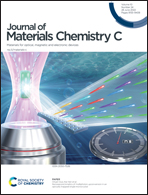Control over microphase separation and dielectric properties via para-fluoro thiol click reaction†
Abstract
Herein, we have reported a para-fluoro thiol click reaction allowing control of the microphase separation and dielectric properties of poly(pentafluorostyrene-b-acrylic acid) copolymers. The block copolymer of pentafluorostyrene and acrylic acid was synthesized with high block incompatibility by nitroxide mediated polymerisation. By using a para-fluoro thiol reaction, 1-dodecanethiol was precisely clicked to block copolymers in various ratios. The microphase structures formed with cylindrical morphologies with a minimum domain size of 5 nm. The orientation of the acrylic acid cylinders varied from horizontal to vertical as the click ratio was increased. The dielectric constant of the copolymers decreases with increasing click ratio because of the low dielectric constant of the dodecane pendant groups and reaches κ = 2.4 (at 1000 Hz). This study provides insights on one-step control over phase and dielectric properties by using a facile and very effective click reaction strategy for the fabrication of novel polymers for next-generation capacitor films used in directed energy and advanced integrated circuits with smaller feature sizes.



 Please wait while we load your content...
Please wait while we load your content...